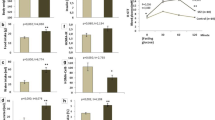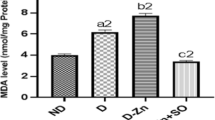Abstract
The objective of the present study was investigation of tissue trace element distribution in a streptozotocin model of DM1 in rats. DM1 was modeled in 2-month-old male Wistar rats (n = 30) using intraperitoneal injection of 45 mg/kg b.w. (STZ1) and 55 mg/kg b.w. streptozotocin (STZ2), whereas control animals were injected with physiological saline. The rats were subjected to oral glucose tolerance test (OGTT) and HbA1c level assessment at day 14. At day 30, blood serum, liver, kidney, and heart samples were collected for tissue trace element assessment using inductively coupled plasma mass spectrometry (ICP-MS). STZ-treated rats were characterized by lack of significant weight gain and elevated HbA1c and blood glucose levels. ICP-MS analysis demonstrated a dose-dependent accumulation of Cu, Mn, Mo, and Se levels in the liver. Correspondingly, the dose-dependent increase in renal Cu, Mn, V, and Zn levels was significant, whereas the observed trend for kidney V and Mo accumulation was nearly significant. The patterns of trace element content in the myocardium of STZ-exposed rats were quite different from those observed for liver and kidney. Only cardiac Zn content was characterized by a significant decrease. Serum Co, Cr, Cu, Se, V, and Mo levels were characterized by a significant decrease in response to STZ-induced diabetes. Generally, the obtained data demonstrate that diabetes is associated with altered copper, manganese, molybdenum, chromium, and vanadium handling. In turn, only altered Zn status may provide a link to diabetic cardiotoxicity. However, the particular mechanisms of both impaired metal handling in STZ diabetes and their potential anti-diabetic activity require further investigation.

Similar content being viewed by others
References
Maahs DM, West NA, Lawrence JM, Mayer-Davis EJ (2010) Epidemiology of type 1 diabetes. J Clin Endocrinol Metab 39:481–497. https://doi.org/10.1016/j.ecl.2010.05.011
Solli O, Stavem K, Kristiansen I (2010) Health-related quality of life in diabetes: the associations of complications with EQ-5D scores. Health Qual Life Outcomes 8:18. https://doi.org/10.1186/1477-7525-8-18
Hex N, Bartlett C, Wright D et al (2012) Estimating the current and future costs of type 1 and type 2 diabetes in the UK, including direct health costs and indirect societal and productivity costs. Diabet Med 29:855–862. https://doi.org/10.1111/j.1464-5491.2012.03698.x
Atkinson MA, von Herrath M, Powers AC, Clare-Salzler M (2015) Current concepts on the pathogenesis of type 1 diabetes—considerations for attempts to prevent and reverse the disease. Diabetes Care 38:979–988. https://doi.org/10.2337/dc15-0144
Rewers M, Ludvigsson J (2016) Environmental risk factors for type 1 diabetes. Lancet 387:2340–2348. https://doi.org/10.1016/s0140-6736(16)30507-4
Lin C-C, Huang H-H, Hu C-W et al (2014) Trace elements, oxidative stress and glycemic control in young people with type 1 diabetes mellitus. J Trace Elem Med Biol 28:18–22. https://doi.org/10.1016/j.jtemb.2013.11.001
Jansen J, Karges W, Rink L (2009) Zinc and diabetes—clinical links and molecular mechanisms. J Nutr Biochem 20:399–417. https://doi.org/10.1016/j.jnutbio.2009.01.009
Samadi A, Isikhan SY, Tinkov AA et al (2019) Zinc, copper, and oxysterol levels in patients with type 1 and type 2 diabetes mellitus. Clin Nutr ESPEN. https://doi.org/10.1016/j.clnu.2019.07.026
Lowe J, Taveira-da-Silva R, Hilário-Souza E (2017) Dissecting copper homeostasis in diabetes mellitus. IUBMB Life 69:255–262. https://doi.org/10.1002/iub.1614
Søgaard KL, Ellervik C, Svensson J, Thorsen SU (2017) The role of iron in type 1 diabetes etiology: a systematic review of new evidence on a long-standing mystery. Rev Diabet Stud 14(2–3):269
Panchal SK, Wanyonyi S, Brown L (2017) Selenium, vanadium, and chromium as micronutrients to improve metabolic syndrome. Curr Hypertens Rep 19(3):10
Flores CR, Puga MP, Wrobel K, Garay Sevilla ME, Wrobel K (2011) Trace elements status in diabetes mellitus type 2: possible role of the interaction between molybdenum and copper in the progress of typical complications. Diabetes Res Clin Pract 91:333–341. https://doi.org/10.1016/j.diabres.2010.12.014
Thompson KH, Chiles J, Yuen VG, Tse J, McNeill JH, Orvig C (2004) Comparison of anti-hyperglycemic effect amongst vanadium, molybdenum and other metal maltol complexes. J Inorg Biochem 98(5):683–690
Forte G, Bocca B, Peruzzu A et al (2013) Blood metals concentration in type 1 and type 2 diabetics. Biol Trace Elem Res 156:79–90. https://doi.org/10.1007/s12011-013-9858-6
Gómez T, Bequer L, Mollineda A, Molina JL, Álvarez A, Lavastida M, Clapés S (2017) Concentration of zinc, copper, iron, calcium, and magnesium in the serum, tissues, and urine of streptozotocin-induced mild diabetic rat model. Biol Trace Elem Res 179:237–246. https://doi.org/10.1007/s12011-017-0962-x
Kowalska J, Krośniak M, Gryboś R, Kwiatek WM (2009) Investigation of trace element concentration in diabetic rat’s tissues. Acta Phys Pol A 115:556–560. https://doi.org/10.12693/aphyspola.115.556
Ozcelik D, Tuncdemir M, Ozturk M, Uzun H (2012) Evaluation of trace elements and oxidative stress levels in the liver and kidney of streptozotocin-induced experimental diabetic rat model. Gen Physiol Biophys 30:356–363. https://doi.org/10.4149/gpb_2011_04_356
Spittle SA, Failla ML (1983) Influence of sex, strain, and species on trace metal status of insulin-deficient diabetic rodents. Biol Trace Elem Res 5:489–502. https://doi.org/10.1007/bf02988941
Lau AL, Failla ML (1984) Urinary excretion of zinc, copper and iron in the streptozotocin-diabetic rat. J Nutr 114:224–233. https://doi.org/10.1093/jn/114.1.224
Barman S, Srinivasan K (2018) Enhanced intestinal absorption of micronutrients in streptozotocin-induced diabetic rats maintained on zinc supplementation. J Trace Elem Med Biol 50:182–187. https://doi.org/10.1016/j.jtemb.2018.07.001
Alghobashy AA, Alkholy UM, Talat M et al Trace elements and oxidative stress in children with type 1 diabetes mellitus. DMSO 11:85–92. https://doi.org/10.2147/dmso.s157348
Weksler-Zangen S, Jörns A, Tarsi-Chen L et al (2013) Dietary copper supplementation restores β-cell function of Cohen diabetic rats: a link between mitochondrial function and glucose-stimulated insulin secretion. Am J Physiol Endocrinol Metab 304:E1023–E1034. https://doi.org/10.1152/ajpendo.00036.2013
Civelek S, Gelişgen R, Andican G, Seven A, Küçük SH, Ozdoğan M, Burçak G (2010) Advanced glycation end products and antioxidant status in nondiabetic and streptozotocin induced diabetic rats: effects of copper treatment. Biometals 23:43–49. https://doi.org/10.1007/s10534-009-9265-9
Nagata M, Kagawa T, Koutou D, Matsushita T, Yamazaki Y, Murase K (2011) Measurement of manganese content in various organs in rats with or without glucose stimulation. Radiol Phys Technol 4:7–12. https://doi.org/10.1007/s12194-010-0098-6
Burlet E, Jain SK (2013) Manganese supplementation reduces high glucose-induced monocyte adhesion to endothelial cells and endothelial dysfunction in Zucker diabetic fatty rats. J Biol Chem 288:6409–6416. https://doi.org/10.1074/jbc.m112.447805
Lee S-H, Jouihan HA, Cooksey RC, Jones D, Kim HJ, Winge DR, McClain D (2013) Manganese supplementation protects against diet-induced diabetes in wild type mice by enhancing insulin secretion. Endocrinology 154:1029–1038. https://doi.org/10.1210/en.2012-1445
Feng W, Cui X, Liu B et al Association of urinary metal profiles with altered glucose levels and diabetes risk: a population-based study in China. PLoS ONE 10:e0123742. https://doi.org/10.1371/journal.pone.0123742
Ozcelikay AT, Becker DJ, Ongemba LN et al (1996) Improvement of glucose and lipid metabolism in diabetic rats treated with molybdate. Am J Physiol Endocrinol Metab 270:E344–E352. https://doi.org/10.1152/ajpendo.1996.270.2.e344
Panneerselvam RS, Govindaswamy S (2002) Effect of sodium molybdate on carbohydrate metabolizing enzymes in alloxan-induced diabetic rats. J Nutr Biochem 13:21–26. https://doi.org/10.1016/s0955-2863(01)00190-5
Liu H-K, Green BD, McClenaghan NH, McCluskey J, Flatt PR (2004) Long-term beneficial effects of vanadate, tungstate, and molybdate on insulin secretion and function of cultured beta cells. Pancreas 28:364–368. https://doi.org/10.1097/00006676-200405000-00002
Tinkov AA, Popova EV, Polyakova VS et al (2015) Adipose tissue chromium and vanadium disbalance in high-fat fed Wistar rats. J Trace Elem Med Biol 29:176–181. https://doi.org/10.1016/j.jtemb.2014.07.006
Clodfelder BJ, Upchurch RG, Vincent JB (2004) A comparison of the insulin-sensitive transport of chromium in healthy and model diabetic rats. J Inorg Biochem 98:522–533. https://doi.org/10.1016/j.jinorgbio.2004.01.003
Vincent JB (2018) Beneficial effects of chromium(III) and vanadium supplements in diabetes. 365–374. https://doi.org/10.1016/b978-0-12-812019-4.00029-5
Mohammadi MT, Pirmoradi L, Mesbah F et al Trophic actions of oral vanadium and improved glycemia on the pancreatic beta-cell ultrastructure of streptozotocin-induced diabetic rats. JOP 15:591–596
Machaliński B, Walczak M, Syrenicz A, Machalińska A, Grymuła K, Stecewicz I, Wiszniewska B, Dabkowska E (2006) Hypoglycemic potency of novel trivalent chromium in hyperglycemic insulin-deficient rats. J Trace Elem Med Biol 20:33–39. https://doi.org/10.1016/j.jtemb.2006.01.002
Somboonwong J, Traisaeng S, Saguanrungsirikul S (2015) Moderate-intensity exercise training elevates serum and pancreatic zinc levels and pancreatic ZnT8 expression in streptozotocin-induced diabetic rats. Life Sci 139:46–51. https://doi.org/10.1016/j.lfs.2015.08.008
Kumar SD, Vijaya M, Samy RP, Dheen ST, Ren M, Watt F, Kang YJ, Bay BH, Tay SSW (2012) Zinc supplementation prevents cardiomyocyte apoptosis and congenital heart defects in embryos of diabetic mice. Free Radic Biol Med 53(8):1595–1606
Li B, Tan Y, Sun W, Fu Y, Miao L, Cai L (2013) The role of zinc in the prevention of diabetic cardiomyopathy and nephropathy. Toxicol Mech Methods 23:27–33. https://doi.org/10.3109/15376516.2012.735277
Author information
Authors and Affiliations
Corresponding author
Ethics declarations
The investigation protocol was approved by the Local Ethics Committee (Institute of General Pathology and Pathophysiology, Russian Academy of Sciences, Moscow, Russia). All animal studies were performed in accordance with the ethical standards laid down in the US guidelines (NIH Publication no. 85-23, amended in 1985).
Conflict of Interest
The authors declare that they have no conflict of interest.
Additional information
Publisher’s Note
Springer Nature remains neutral with regard to jurisdictional claims in published maps and institutional affiliations.
Rights and permissions
About this article
Cite this article
Karganov, M.Y., Alchinova, I.B., Tinkov, A.A. et al. Streptozotocin (STZ)-Induced Diabetes Affects Tissue Trace Element Content in Rats in a Dose-Dependent Manner. Biol Trace Elem Res 198, 567–574 (2020). https://doi.org/10.1007/s12011-020-02090-2
Received:
Accepted:
Published:
Issue Date:
DOI: https://doi.org/10.1007/s12011-020-02090-2




